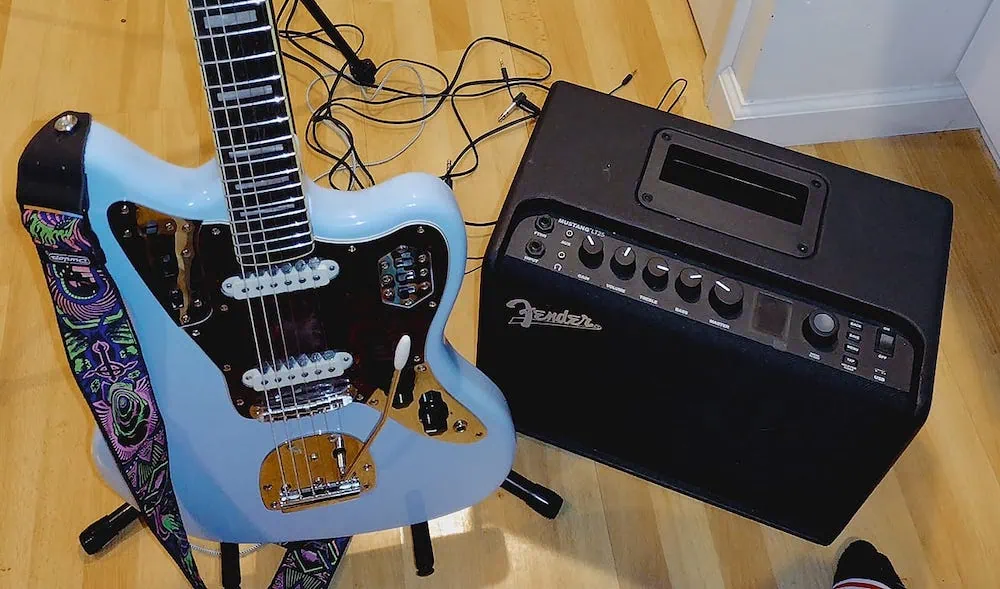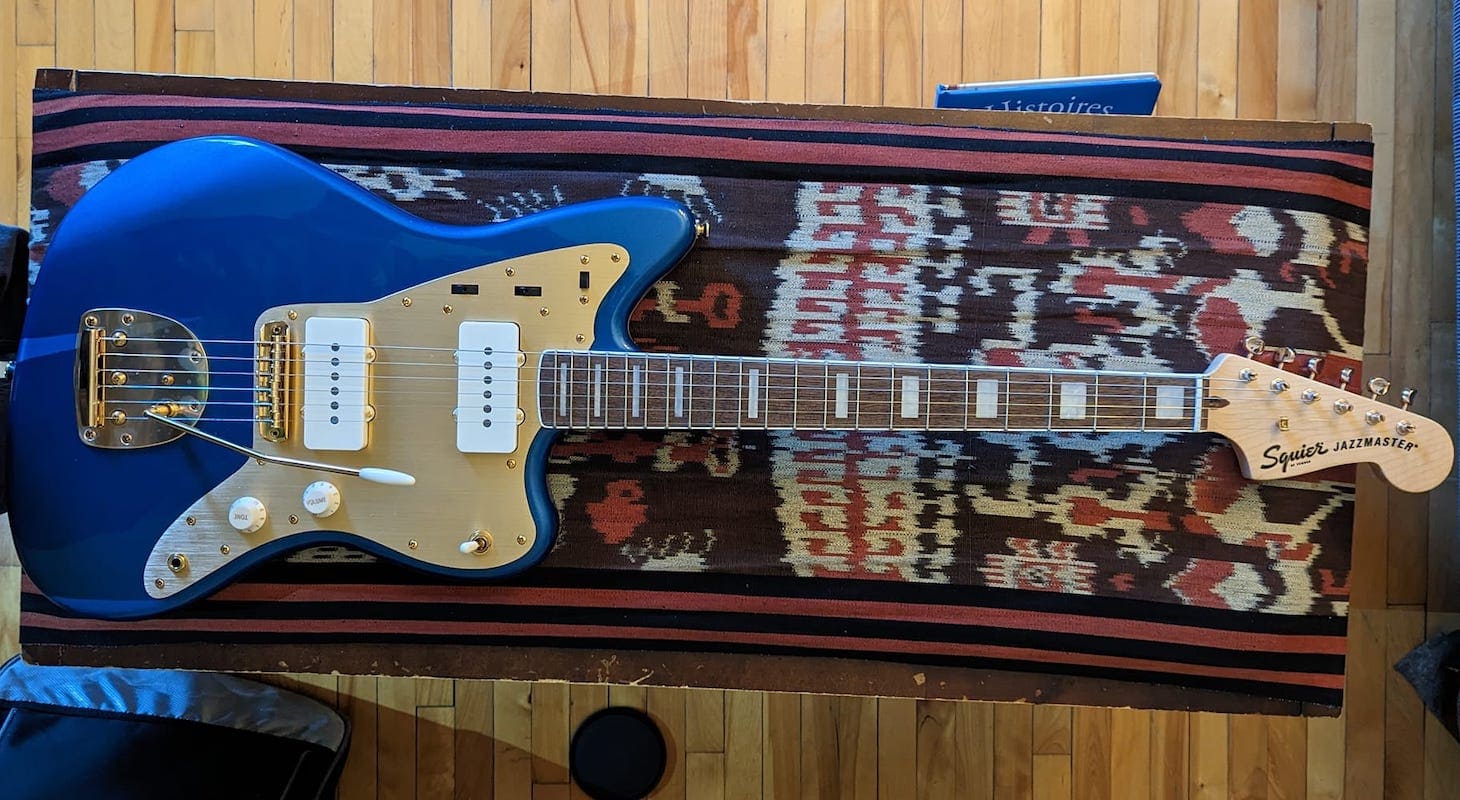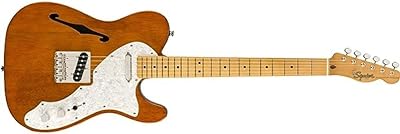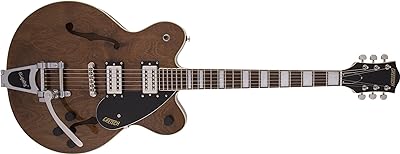In my decades as a guitar player, I have often changed the direction of my playing. I went from a punk attitude toward alternative music, singing-songwriting, and even bossa nova and tango.
I wasn’t freer and wilder creatively speaking at no other point in my musical career as I was in my Shoegaze years. The guitar transforms into a brush with a million colors that helps you paint landscapes full of psychedelic fantasy and powerful rocking tones.
Those were formative years for me and helped me erase the barriers between my imagination and the speakers. Since Shoegaze gave me so much as a player, I thought I could give some back to you and help you choose the best guitar to play this fantastic style full of freedom and weirdness.
Here are my choices for the best Shoegaze guitars on the market today.
The Best Guitars for Shoegaze
1. Jazzmaster
The Jazzmaster is to Shoegaze what the Les Paul is to Hard Rock. Yes, you can’t take the guitar away from the music style and you can’t take the music style out of the guitar.
Although it is a shape gaining much popularity, if you spot someone on stage with a Jazzmaster, you think they play alternative music, indie rock, or shoegaze.
But why is the Jazzmaster a shoegaze favorite? In my opinion, and after playing the genre for years, I can say it has a lot to do with how big and sharp this guitar sounds.
Yes, the Jazzmaster’s huge body and single-coil pickups create a beast with an edge. Moreover, being an alder guitar with a maple neck, you have enough treble to cut through the mix.
Believe me, shoegaze mixes are super dense.
But that’s only 50% of the equation because the other 50% is in the vibrato system. No other vibrato works, sounds, and feels like the Panorama vibrato system. With it, you can do the classic Kevin Shields oscillating movement as you play. This gives your playing a 3-D quality that keeps songs moving forward.
But, what are the Jazzmaster models you should be looking at? Well, in my opinion, Squier’s Classic Vibe and J Mascis (Dinosaur Jr.) models are ripping and very affordable.

Squier J Mascis Jazzmaster
If your budget allows you to go one step forward into Fender, I would say you’ll get more definition, better pickups, and a gig bag with a ‘60s Vintera Jazzmaster.
Furthermore, if you can go all-in and buy the best Jazzmaster Fender makes as a line instrument, you can get the American Vintage II Jazzmaster.
Despite being (or because it is) a faithful recreation of the original, it also carries on all the problems the original guitar had (the vintage bridge and 7.25” radius).
To solve those problems, you can go for a more modern iteration preserving sound quality with the American Ultra Jazzmaster. If your budget isn’t so bulky, the American Professional II Jazzmaster is an amazing deal.
2. Jaguar
The Fender Jaguar has always been quite an odd offspring of the offset era. Yes, it’s a surf-ready machine with enough chrome appointments to make Cadillac owners jealous, but it’s also a short-scale single-coil jangle machine.
So, to begin with, Jaguars are tone and scale-wise, the smaller version of the Jazzmaster. The pickups sound smaller and the 24” scale might not be everyone’s cup of tea. Yet, if you dial in the shoegaze tone, the lower output of the pickups and the treble-oriented sound allows the Jaguar to cut through the mix as few other guitars can.
Maybe, the first time you plug a Jaguar in, you’ll feel that there’s no bass on the resulting sound. But let me tell you that, if you play with the tone knob a little and toggle between the circuits, you’ll find a ton of useful sounds.
Moreover, since it is a guitar designed for the surf rock scene, you can drench it with reverb, drown it with delay, and put a ton of fuzz on top, and you’ll always hear the notes you’re playing.
Plus, it comes equipped with, in my opinion, the best tremolo system ever made.
If you want to dip your toes in the Jaguar world without breaking the bank or have a limited budget, the Squier Classic Vibe Jaguar is a great bang for the buck.

Squier Classic Vibe '70s Jaguar next to my Fender Mustang LT25 amp.
For those with a bulkier budget, the maple-fretboard Vintera II '70s Jaguar is a great guitar with even more edge than a regular Jaguar.
Finally, if you can spend a little more, I have to recommend the Johnny Marr signature Jaguar. With a simplified control layout and tons of mojo, you can’t go wrong playing shoegaze with it.
3. Mustang
My choice among Fender offset guitars for playing shoegaze music will always be a Fender Mustang. I’m the lucky owner of a 1966 extraordinary specimen and I love it to the bone.
But why is the Mustang the perfect shoegaze guitar? Well, in my opinion, it’s the best because it can take pedals better than any other offset. Yes, the super-low output pickups are great for the layers of distortion and fuzz not to turn into a swamp.
Moreover, it features a great tremolo system that allows the wobbly effect. Plus, if you’re not so tall or big, a Mustang is much more maneuverable than a Jazzmaster or Jaguar.
I use mine with my Big Muff Pi, two Tube Screamers, drenched in reverb, soaked in delay, and with some modulation on top (vibrato, chorus, phaser, and tremolo) and I can always hear my guitar crystal-clear.
I mean, while Kevin Shields was creating a new world of sound for My Bloody Valentine’s Loveless album using Jazzmasters and weird tunings, Bilinda Butcher was adding beauty to the mayhem with a Mustang.
I have to tell you that I just love that Squier and Fender brought the competition stripes back.
The Classic Vibe '60s Mustang is a great guitar with the looks and tones you need for shoegaze. Speaking of which, the in-and-out-of-phase slider switches on top can give you 6 very usable sound combinations. Plus, the tremolo system is just smooth and great.

Squier Classic Vibe '60s Mustang
If your budget allows a little more, the Fender Vintera II '70s Mustang turns everything that’s great about the Classic Vibe into HD. If you feel you need more treble to cut through the mix, the Ben Gibbard Mustang is the perfect guitar with its maple neck and chambered ash body.
Finally, if you feel slider switches mess with your live performance, your budget allows it, and you want something a little more solid and made in the USA, the American Performer Mustang should be your new partner in crime.
4. Thinline Telecaster
I know what you’re thinking right now, and I agree with you. There are very few Telecasters in the Shoegaze scene. Yet, if you ever see Lush live and witness what Emma Anderson does with hers, you’ll surely change your mind.
The thing about Thinline Telecasters is that they have semi-hollow bodies that can perfectly blend the treble-oriented tone of the Telecaster with some low-end coming from the hollow body. Thus, what you get is a big guitar tone that can stay on the surface of the mix regardless of what you throw at it.
In my experience, the Classic Vibe '60s Telecaster Thinline takes pedals, and especially fuzz, much better than the ‘70s version with the dual humbuckers. That said, Fender Wide Range humbuckers are among the most musical and effect-friendly humbuckers in the market.
Hey, they are the pickups noise rock legend Lee Ranaldo put on his signature Jazzmaster after all, aren’t they?.
Beyond sound and pickups, there’s something about the neck of Fender Telecasters and its 25.5” scale that is so familiar to regular Fender players that you immediately know what to play when you pick this guitar up. Moreover, the string tension is just perfect for chords and melodies.
Finally, if your budget allows for a little more, everything turns HD when you get a Fender Vintera II '60s Telecaster Thinline or, for a bulkier budget, an American Vintage II 1972 Telecaster Thinline or a Fender Britt Daniel Telecaster Thinline.
5. Center Block Gretsch Guitars (w/ Bigsby)
Gretsch guitars are a type of instrument you can find on stages as diverse as stages get. Shoegaze is no exception to that rule. For example, here you can see the legendary Shoegaze band Ride rocking the KEXP stage with a tandem of a Gibson Trini Lopez and a Gretsch Country Gentleman.
But, why are Center-block Gretsch guitars great for Shoegaze? Well, they carry that same combination of the hollow body and, most of them, a maple neck that gives the guitar plenty of growl and also enough treble to remain clear despite the myriad of effects.
Adding to that, the center block, in some cases made of solid spruce, and others made of maple also offers enough treble to cut through the mix.
Also, the Bigsby vibrato arm is great to make up for the Panorama Tremolo in Jazzmasters and such. You can perform swells, dives, and details with it. Finally, the body itself in these guitars is made of laminated maple, adding that brightness you need to shine through a dense mix in a band.
So, for those with an entry-level budget, the Gretsch G2622T Streamliner is the perfect instrument to build your Shoegaze chops on. It sports a 5-ply maple body, a center block, a maple neck, and a laurel fretboard to add a pinch of sweetness to the mix.
If your budget allows it, the next step in quality is the Gretsch G5655TG Electromatic, a higher-end version of the previous guitar but with a single cutaway.

Gretsch G5655TG
Finally, if you want to buy the best version of this guitar available today, the Japanese-made Gretsch G6636T Players Edition Falcon plays and sounds as astonishingly well as it looks. Plus, that ebony fretboard adds snap and definition to the resulting sound.
6. Honorary Mention, Paranormal Jazzmaster XII
This list couldn’t be complete if I didn’t add an honorary mention to one of the hippest, most audacious, and Shoegaze-friendly guitars Squier has put out in the past decade. Yes, I’m talking about this Jazzmaster with 12 strings and the quintessential (super cool if you ask me) hockey stick headstock.
But what’s cool about this guitar for Shoegaze? Well, there are plenty of weird sounds and layers in these bands’ records in which they use chorus, delay, reverb, and other effects to create a warbly, 3-D-like melodic environment to lay those ethereal lyrics.
Moreover, some bands even doubled or tripled their distorted guitar tracks to create a “wall of sound” (Yes, the folks from The Grateful Dead are so proud of you!).
Well, the minute I plugged this guitar in, I knew it had every ingredient a guitar needs to excel at shoegazing. Perhaps, the only thing missing is the tremolo system, but do you imagine working a tremolo system on a 12-string guitar? Me neither.
If you’re buying an instrument to be your only axe, I wouldn’t recommend it, but this 12-string Jazzmaster is a great addition to your Shoegaze-ready guitar arsenal. Oh, and it won’t break the bank either!
Reverb, the Biggest Shoegazer Ally
Nothing makes your guitar sound as washy, trippy, ethereal, and huge as reverb. I know what you’re thinking “Hey, my amp has a really cool reverb!” Well, I’m talking about something way more complex that drifts away from surf music to give more color and nuances to the sound.
So, if you don’t even have onboard reverb on your amp, you can get started with the TC Electronic Skysurfer. It has all you need to start making your guitar sound wider, bigger, and more ethereal.
Now, if you can invest a little more and move on to the Boss RV-6, you’ll get a plethora of new reverb sounds and modes to play with including modulated reverb and shimmer.
For just a handful of dollars more, the Catalinbread Soft Focus Shoegaze Reverb is the perfect choice. I mean, the name implies it; it’s a pedal that’s instantly Shoegaze-friendly but offers many tonal options.
This pedal in particular had me entertained playing most of the Loveless songs I know for hours. It can do amazing reverb but also chorus, modulation, and an octave up.
For players with a big budget, I can recommend two pedals that offer virtually endless possibilities. The first is the Strymon BigSky and the second is the Empress Effects Reverb. These are the perfect pedals to take any pedalboard into Shoegaze territory. Plus, tinkering with the reverse reverb modes and adding some delay will get you into Shoegaze heaven.
What Effects Does Your Shoegaze Pedalboard Need?
What are the pedals you need for that Shoegaze-friendly pedalboard of yours? Well, these are just some basic options, you can enlarge this list as much as you like with all kinds of fuzzes, boutique gizmos, and weird effects.
- Reverb
- Delay
- Overdrive
- Fuzz
- Distortion
- Tremolo
- Chorus
- Flanger
- Phaser
- Vibrato
A Tip on Pedal Order to Get the Shoegaze Sound
I’ve been playing alternative music, rock, and metal for, at least, two decades. During that time, my pedalboard grew exponentially, then diminished to the bare minimum, and now I’ve (kind of) found an equilibrium.
Yet, there’s one thing to understand about Shoegaze: Effects take the front of the stage.Yes, this means pedals will be the core of your tone and performance.
Fun fact, the term “shoegaze” comes from players looking at their feet instead of the audience as they play. Well, players weren’t looking at their sneakers, but the pedals, the true rulers of Shoegaze..
So, you need to use them to create The Shoegaze Sound. For that, you need to do something nobody else does: put your tremolo pedal before anything else.
This will give your guitar a warbly, oscillating sound (kind of what Kevin Shields did with MBV) that gives movement and life to any track.
Furthermore, here’s a video about an innovative way of using an inexpensive tremolo pedal to create a huge Shoegaze tone.
Single-Coil Pickups, Reverb, Delay, and a Match Made in Heaven
You must have noticed that I included no Super Strats or metal-oriented guitars on the list. The reason behind doing this is that high-output pickups aren’t at all what you need to play Shoegaze.
How so? You might be wondering as the Floyd Rose of your Kramer Baretta shines under the dazzling sunlight coming through your window.
Well, the answer is very simple, those pickups can’t take pedals the way single-coil pickups can. Furthermore, they tend to drive the amp, the overdrive, the distortion, and the fuzz pedal into mud territory. Add to that mix some reverb and delay, and you’ll be drawn into a tone swamp.
Therefore, reverb, delay, and single-coils are a match made in heaven for Shoegaze and, in my opinion and experience, the path to a great Shoegaze tone.
Cutting through the Mix
Cutting through a mix as dense as the one you find on any Shoegaze album or show is no easy endeavor. On the contrary, you need to have enough edge on your tone to bring the guitar sound to the surface.
Thus, to help those single coils, you should stick to tone woods like maple, spruce, ash, alder, and (if the budget allows) ebony. Guitars made of these materials can help you make that job easier.
The Bottom End
Shoegaze is all about freedom, fun, and experimenting with the idea of what a guitar can do. I remember the first time I set my reverb to a reverse mode and discovered beauty in dissonance. After that, my world just wasn’t the same anymore. Music can do that to all of us.
So, pick the guitar that best suits your hands and needs, and go play some ethereal, dreamy, fierce, and creative Shoegaze songs.
Happy (reverb-drenched) playing!






